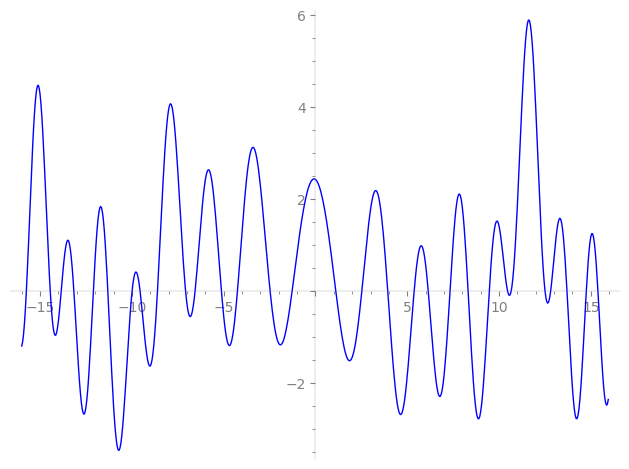| L(s) = 1 | + (11 − 2i)5-s + 27·9-s + 92i·13-s − 104i·17-s + (117 − 44i)25-s + 130·29-s + 396i·37-s + 230·41-s + (297 − 54i)45-s + 343·49-s − 572i·53-s + 830·61-s + (184 + 1.01e3i)65-s + 592i·73-s + 729·81-s + ⋯ |
| L(s) = 1 | + (0.983 − 0.178i)5-s + 9-s + 1.96i·13-s − 1.48i·17-s + (0.936 − 0.351i)25-s + 0.832·29-s + 1.75i·37-s + 0.876·41-s + (0.983 − 0.178i)45-s + 49-s − 1.48i·53-s + 1.74·61-s + (0.351 + 1.93i)65-s + 0.949i·73-s + 0.999·81-s + ⋯ |
Λ(s)=(=(320s/2ΓC(s)L(s)(0.983−0.178i)Λ(4−s)
Λ(s)=(=(320s/2ΓC(s+3/2)L(s)(0.983−0.178i)Λ(1−s)
| Degree: |
2 |
| Conductor: |
320
= 26⋅5
|
| Sign: |
0.983−0.178i
|
| Analytic conductor: |
18.8806 |
| Root analytic conductor: |
4.34518 |
| Motivic weight: |
3 |
| Rational: |
no |
| Arithmetic: |
yes |
| Character: |
χ320(129,⋅)
|
| Primitive: |
yes
|
| Self-dual: |
no
|
| Analytic rank: |
0
|
| Selberg data: |
(2, 320, ( :3/2), 0.983−0.178i)
|
Particular Values
| L(2) |
≈ |
2.426969299 |
| L(21) |
≈ |
2.426969299 |
| L(25) |
|
not available |
| L(1) |
|
not available |
L(s)=p∏Fp(p−s)−1 | p | Fp(T) |
|---|
| bad | 2 | 1 |
| 5 | 1+(−11+2i)T |
| good | 3 | 1−27T2 |
| 7 | 1−343T2 |
| 11 | 1+1.33e3T2 |
| 13 | 1−92iT−2.19e3T2 |
| 17 | 1+104iT−4.91e3T2 |
| 19 | 1+6.85e3T2 |
| 23 | 1−1.21e4T2 |
| 29 | 1−130T+2.43e4T2 |
| 31 | 1+2.97e4T2 |
| 37 | 1−396iT−5.06e4T2 |
| 41 | 1−230T+6.89e4T2 |
| 43 | 1−7.95e4T2 |
| 47 | 1−1.03e5T2 |
| 53 | 1+572iT−1.48e5T2 |
| 59 | 1+2.05e5T2 |
| 61 | 1−830T+2.26e5T2 |
| 67 | 1−3.00e5T2 |
| 71 | 1+3.57e5T2 |
| 73 | 1−592iT−3.89e5T2 |
| 79 | 1+4.93e5T2 |
| 83 | 1−5.71e5T2 |
| 89 | 1+1.67e3T+7.04e5T2 |
| 97 | 1+1.81e3iT−9.12e5T2 |
| show more | |
| show less | |
L(s)=p∏ j=1∏2(1−αj,pp−s)−1
Imaginary part of the first few zeros on the critical line
−11.30998510555258313307458755969, −9.987836193224612094693890950500, −9.553716625062177340444559116481, −8.605416351110581546438675354429, −7.07496566472422275325860357065, −6.55793097876415324198428815531, −5.12210525051756329349756107597, −4.24969900961530370403976375404, −2.47041010066281396351503514633, −1.27113362172153832304053666927,
1.10795957326549134486653797820, 2.52544736311374169812265038982, 3.93774191750573984236258134170, 5.37616669333440697868220933832, 6.14292864079838496245629492831, 7.32954636025287382537985767739, 8.314249022432188667688014427833, 9.467293736291278086317177880099, 10.46530810280346546523870865482, 10.66245508300188475930443054229

